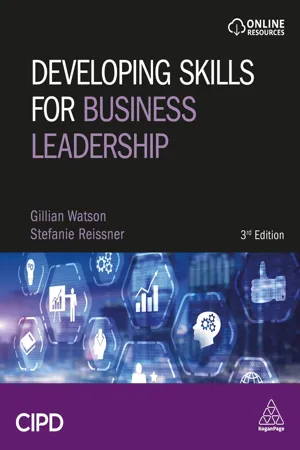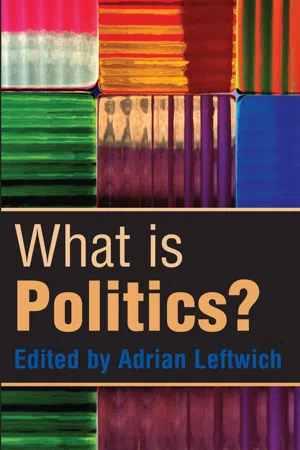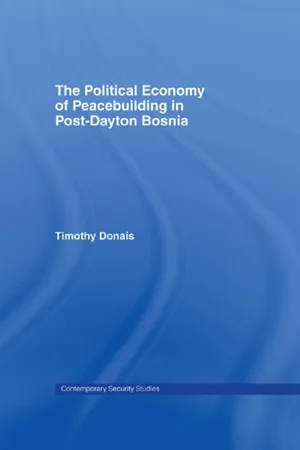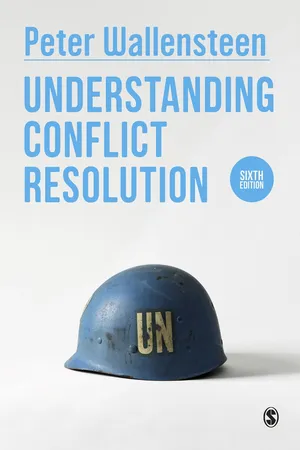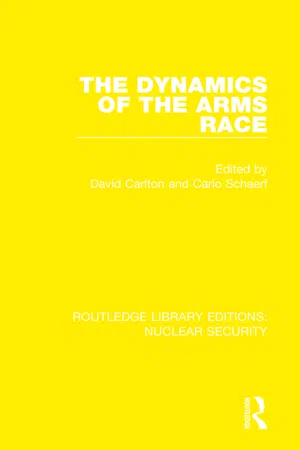Politics & International Relations
Political Conflict
Political conflict refers to disagreements and disputes between individuals, groups, or institutions over power, resources, or values within a political system. It can manifest in various forms, such as protests, strikes, or violence, and can have significant impacts on the stability and legitimacy of a political system.
Written by Perlego with AI-assistance
Related key terms
Related key terms
1 of 4
Related key terms
1 of 3
6 Key excerpts on "Political Conflict"
- eBook - ePub
- Sabine C. Carey(Author)
- 2009(Publication Date)
- Routledge(Publisher)
2 Domestic conflict and political regimesThis chapter outlines the dynamics between protest, repression and political regimes. It discusses how repression and protest influence each other, and how the characteristics of this relationship are expected to differ in different political systems. The first part of this chapter defines the main phenomena of domestic Political Conflict, repression and protest. The second part develops a theory of domestic conflict and derives hypotheses that are tested in the following chapters.DEFINING DOMESTIC Political Conflict
Social conflict has been defined as ‘a struggle over values or claims to status, power, and scarce resources, in which the aims of the conflict groups are not only to gain the desired values, but also to neutralize, injure, and eliminate rivals’ (Coser 1967: 232). It is a struggle over influence and power. I argue that this struggle is, in general, a zero-sum game. The gains of one actor are the losses of another. The increase of power and influence usually comes at the cost of the decreased power and influence of another actor. In the following, I focus on political conflict, on the struggle over power and resources that rival groups typically engage in. I assume that both protesters and the state attempt to increase their influence and control over political issues, and try to weaken the opponent.Gurr and Lichbach define Political Conflict as ‘open physical confrontations between collective actors over political issues’ (1986: 5). Based on this definition, Political Conflict has three main elements: (1) actions, which are (2) fuelled by political issues and (3) carried out by collective actors. I impose the additional criterion that the collective actors must be domestic actors. For example, confrontational acts by foreign politicians or by foreign media are not part of the concept of Political Conflict as it is understood within this context. For the purpose of this book, domestic Political Conflict is defined as confrontation by domestic actors over political issues. In this sense, domestic Political Conflict includes, but is not restricted to, ‘sustained, conflictual interaction between social challengers and opponents’ (Tilly 1984: 299).1 - eBook - ePub
Developing Skills for Business Leadership
Building Personal Effectiveness and Business Acumen
- Gillian Watson, Stefanie Reissner(Authors)
- 2023(Publication Date)
- CIPD - Kogan Page(Publisher)
In this chapter, we will explore conflict in organisations. We will start with defining conflict and then consider the role of power and politics in workplace conflict. We will then examine the consequences of poor conflict management in organisations (including manifestations such as workplace incivility, bullying and harassment), before discussing how conflict can be dealt with more constructively. In this context, we will identify the interpersonal and managerial capabilities that are essential to the efficient diffusion and long-term resolution of conflict. We will discuss mediation as an effective way of dealing with workplace conflict and the often untapped skills that could aid mediation. We will also establish the importance of clear organisational policies and procedures that will help managers and staff to manage conflict and consider the skills and capabilities that managers and HR professionals can use when seeking to resolve it. Note that a discussion of larger-scale conflict (such as industrial action) is beyond the scope of this chapter; details can be found in a specialist industrial or employment relations textbook.Defining conflict
Conflict can be regarded as a serious and often protracted disagreement. It occurs if an individual or group believe that they are being restricted from getting what they want or are entitled to, and/or if their beliefs and values are undermined, and/or if they feel under threat. Conflict can be constructive, a revitalising force that invigorates established relationships and promotes new ones (Tjosvold et al, 2019). But conflict can also be destructive, disrupting working practices, damaging alliances and devastating relationships. A slightly different terminology is used by Liddle (2017) who describes conflict as either functional (‘valuable, productive and healthy’) or dysfunctional (‘damaging and harmful’). It is the latter type of conflict that makes many people avoid it as an interruption to harmony, relationships and routines. - eBook - ePub
What is Politics?
The Activity and its Study
- Adrian Leftwich(Author)
- 2015(Publication Date)
- Polity(Publisher)
From its origins in the Peace Treaties of Westphalia in 1648, the institution of the modern state has evolved over the last four centuries to become the principal unit of political rule. Empires and city states gave way to nation states or state-nations. Nationalism and democracy reinforced the idea of the modern state as a sovereign, self-governing, territorially delimited and culturally homogeneous political unit. Much of the history of state formation in the nineteenth and twentieth centuries was accordingly bloody. Consequently, the conventional wisdom has it that politics is an activity that occurs within a bounded political community – namely, the nation state, which is normally thought to be constituted by shared norms, rules and governmental institutions which in turn exercise sovereign political authority. Politics is concerned ultimately with matters of governance and persuasion within a highly institutionalized political and legal order in which violence is illegitimate. Beyond the sovereign (national) political community, within the society of states, there is at best only a thin sense of community, no effective central political authority, and thus only a weakly institutionalized world order. In these circumstances, power ultimately trumps legality and legitimacy such that politics is essentially an activity defined by the struggle for power by coercive and violent means where necessary. To paraphrase Clausewitz, war is the continuation of politics by other means. Politics between states (or discrete political communities) is thus a radically different kind of activity to politics within the bounded political community. Such a stark differentiation between domestic and international politics is central to the orthodox conception of political life. It is expressed concretely in separate programmes of study for ‘politics’ and ‘international relations’, and sometimes replicated in separate Departments of Politics and International Relations.A different reality
However, the Westphalian ideal of discrete, self-governing, sovereign political communities has always been at odds with the historical realities of global flows and movements of ideas, goods, people, technology and capital. Indeed, in a curious way, it is the desire of governments and peoples to control what transpires within their borders which has contributed to political globalization. Sovereignty, understood as the rightful claim to, and capacity for, self-governance, has always been decidedly problematic, if not in practice a form of ‘organized hypocrisy’ (Krasner, 1999). Politics has always had a global dimension. The movement for the abolition of slavery in the eighteenth century organized transnationally. During the American Civil War (1861–3) the cotton workers of Manchester provided support and demonstrated their solidarity for the Union cause. Peace campaigners from across the world lobbied governments for effective action to regulate international conflicts at the historic Hague Conferences in the late nineteenth century. Patterns of global economic integration, since the days of the East India Company, have enmeshed the political economies of states and communities in different regions of the world within a single global division of labour. And the combination of industrialized warfare and geopolitical competition turned the world into a single strategic arena in which distant but local conflicts could escalate into global confrontations. Politics has never stopped at the water’s edge, so to speak, and the Westphalian ideal has always represented the exception rather than the rule. So, what is new? - Timothy Donais(Author)
- 2005(Publication Date)
- Routledge(Publisher)
causes of conflict remains a matter of some debate, “the need to incorporate, at some level and in some form, the ‘economic dimension’ in order to better understand the causes and the persistence of conflict is uncontroversial” (Berdal and Malone 2000: 1).In part, the study of the political economy of conflict has emerged in response to concrete developments in the post-Cold War era. Internal conflicts in the aftermath of the Cold War have demonstrated a much more obvious economic nature, largely because of the relative decline of ideological conflicts and the reduced ability of conflicting parties – be they rebels or governments – to rely on financial support from external sponsors. During the Cold War, for example, both sides in Angola’s civil war, or in El Salvador’s, could rely on considerable support from super-power backers pursuing by proxy their own ideological and geopolitical aims. With the evaporation of the East–West confrontation, contending sides within civil conflicts now have to fend for themselves in terms of financing their military activities (Duffield 2000: 73). As a result, control of vital economic resources, be it diamonds in Sierra Leone or Angola, timber in Cambodia, or drugs in Colombia, has become a key battleground in recent civil conflicts.At the same time, the gradual emergence of the study of the political economy of conflict as a subfield of international relations is part of the ongoing effort to better understand the dynamics of contemporary conflict. This has become increasingly relevant in the present era, in which the international community has come under growing pressure to respond to conflict with peacemaking and peacebuilding strategies. Following the logic that “a good doctor will need to get some idea of the nature of the disease before rushing to the medicine cabinet to pull out a remedy” (cited in Berdal and Malone 2000: 20), there has consequently been a renewed emphasis in recent years on understanding the underlying dynamics of war. Focusing on the economic dimensions of civil conflict as one piece of a larger puzzle, in this sense, provides a more promising avenue for potential international responses than earlier approaches, which have tended to see conflict as irrational and therefore not amenable to constructive international intervention. Even today, most mainstream analyses of civil conflicts – including, for example, the growing literature on the phenomenon of “failed states” – continue to view such conflicts as breakdowns, or as deviations from a normal state of affairs, with the goal of international intervention being the restoration of normalcy. As Gilles Carbonnier has noted, students of international security have not been alone in considering violent conflicts as aberrations. Until very recently, in fact, “the overwhelming majority of economists and development agencies tended to consider war an external event, not amenable to economic analysis, ‘which disrupts from time to time more normal conditions under which economic laws apply’” (Carbonnier 1998). One danger of this perspective, of course, is that it tends to obscure the extent to which the roots of any particular conflict can be found in the assumed “normalcy” of the status quo ante- eBook - ePub
- Peter Wallensteen(Author)
- 2023(Publication Date)
- SAGE Publications Ltd(Publisher)
There are also other aspects of peace. Conflict resolution finds itself at a bridge between a very narrow concept of peace (no war) and a very broad one (justice). By leaving conflict resolution as a concept defined by the positions of the parties, it may become difficult to compare one situation to another. However, the fact is that there are increasingly established norms for the content of internationally acceptable peace agreements. International law has set some standards for conflict resolution between states. The end of the Cold War has also led to signposts for the settlement of internal conflicts: Principles of democracy, human rights, criminal justice, reconciliation and economic cooperation are part of this. In this sense, an international understanding of conflict resolution is developing. For instance, the sustainable development goals established in 2015 include matters of peace and rule of law in its 16th goal. Like the others, implementation is under continuous scrutiny. This and other measures contribute to pushing the concept of peace further in the direction of justice. These higher demands of peace can be summarized as a quest for quality peace: a peace that has a greater chance of preventing the recurrence of war and at the same time produces societies or inter-state relationships that are beneficial to all.1.6 Causes of Conflict and Conflict Resolution
The definition of conflict resolution that is used here does not include larger issues such as the ‘removal of the root causes of conflict’. The focus is instead on what the parties engaged in a war can agree to. The assumption is that these root causes will be covered by the stipulations that are included in the deal that the parties can live with. Whether that will be the case is a result of the negotiations, and is likely to vary between agreements. Although some peace documents can be as comprehensive as in the Colombian agreement of 2016 it does not necessarily go as far as implied in the UN Security Council resolution 2282 from April 2016. The conditions for sustaining peace in the context of peacebuilding are ‘broadly understood as a goal and a process to build a common vision of a society, ensuring that the needs of all segments of the population are taken into account, which encompasses activities aimed at preventing the outbreak, escalation, continuation and recurrence of conflict, addressing root causes, assisting parties to conflict to end hostilities, ensuring national reconciliation and moving towards recovery, reconstruction and development’. This resolution was unanimously passed in the Security Council parallel to an identical resolution in the UN General Assembly at about the same time (Resolution 70/262). Thus, the UN is operating with a wide peace definition where conflict resolution is an integral but implicit element. It approaches the notion of ‘quality peace’ which seeks to capture what can be empirically documented in such a wider context. It may also be a way of describing conflict transformation. - eBook - ePub
- David Carlton, Carlo Schaerf(Authors)
- 2020(Publication Date)
- Routledge(Publisher)
PART IIITHEORY OF CONFLICT AND SOME REGIONAL CASE STUDIESPassage contains an image
18.A COMPARATIVE APPROACH TO THE STUDY OF INTERNATIONAL CONFLICT
Alan DowtyThe whole idea of comparative international politics begins with a perhaps simple-minded proposition. This proposition holds that one of the best ways to study any international phenomenon is to compare different systems of international relations in diverse historical periods, and not in the modern period alone. This can be extended to the study of international conflicts. Such an approach rests on the power of comparison as a technique that makes it possible to identify the common elements of different systems, or what is basic to any system of international relations, thus isolating what is unique to any particular system, and particularly what is genuinely unique in the modern international system.We can think of this in terms of three levels of causation in international conflicts. The first and most basic level of conflict is that inherent to any system of interacting sovereign states, or what might be called the strategic imperative of international conflict. An example would be the simple maxim that the enemy of my enemy is my friend. In other words, these are the patterns of conflict that appear in any international system, regardless of cultural context or historical period.The second level of causation in international conflict is behaviour specific to one kind of international system (bipolar or multipolar, for example) which is likely to recur in different historical periods. Such sources of behaviour are more particular than the very general level above, but still embrace more than one historical period. An example might be the idea that in a multipolar system alliances tend to be fluid and that defeated states have to be re-admitted to the system in order for it to operate properly.
Index pages curate the most relevant extracts from our library of academic textbooks. They’ve been created using an in-house natural language model (NLM), each adding context and meaning to key research topics.
Explore more topic indexes
Explore more topic indexes
1 of 6
Explore more topic indexes
1 of 4

